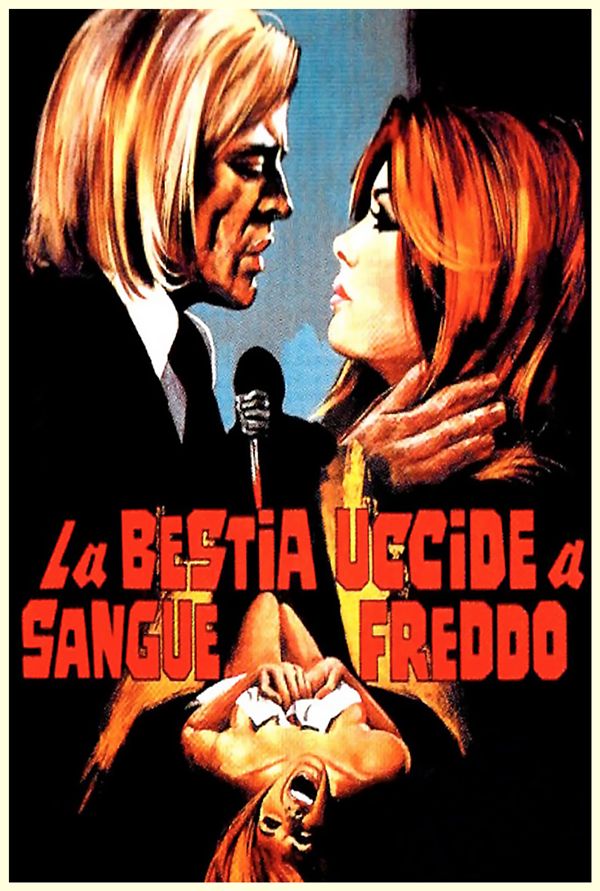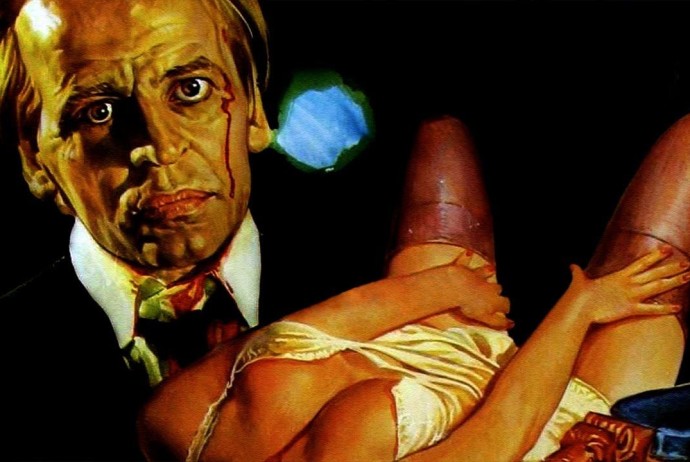Dir: Fernando Di Leo
Star: Klaus Kinski, Margaret Lee, Rosalba Neri, Jane Garret
a.k.a. Asylum Erotica, Cold Blooded Beast and Slaughter Hotel
The last alternate title is particularly inappropriate, since it’s not a hotel and there’s a disappointing deficit on the slaughter front. My God, this is tedious. I know Kinski had a tendency to appear in anything, but even he looks bored out of his mind, in his role here as Dr. Francis Clay. Clay is the head of a mental sanatorium which, for reasons which quickly become clear to the viewer (if not any needed by the plot), appears to serve only young, female and attractive loonies. Someone in a mask is going round, picking off the staff and patients with a variety of weapons, but showing particular fondness for an ax. Inexplicably, nobody seems to notice this, until about 15 minutes before the end, when a crossbow bolt through the neck galvanizes the authorities into action, and they set a trap for the killer, using one of the patients as bait [it’s okay, she’s been cured, so it’s not really exploiting the mentally ill].
However, it’s nowhere near as interesting at that might make it sound. A better summary of the movie is to be found in the opening sequence, of the killer creeping round the corridors of the hospital before being scared off. This utter non-event lasts a full six minutes, close as I could figure out. What there also is, instead of plot, characterization or even good old-fashioned splatter, is an awful lot of nudity, with just about every actress here chosen not for their thespian talent, as an apparent willingness to get their kit off. Some of this is surprisingly explicit, given the time and the somewhat mainstream nature of this as a film, but it’s all depicted in such a boring manner, even red-blooded heterosexual males (or lesbians – we are nothing if not inclusive here) may find themselves fast-forwarding through the nudity to get back to the rest of the film.
Dr. Clay, naturally, has a relationship with one of his patients, Cheryl Hume (Lee), in violation of just about every medical ethic. Mind you, the way this mental institute just leaves lethal weapons around, should also bring local health and safety down on them. I mean: they have a working iron maiden, f’heaven’s sake, and don’t even bother to lock it! That’s just asking for a class-action law-suit, I’d say – even before the obvious happens with it – and I imagine a sequel depicting Dr. Clay declaring bankruptcy as a result of the resulting damages he has to pay out for negligence, to the victim’s families. And oh, look: another inmate, Anne Palmieri (Neri), is a raging nympho. What are the odds? Take your time curing that one, Dr. Clay. But it’s the relationship between Nurse Helen (Monica Strebel) and patient Mara (Garret) that provides a particularly large does of the gratuitous nudity, which is clearly Di Leo’s main purpose for making this one. Massage! Tribal dance! Lesbian canoodling! Truly, this film has something for everyone – at least, providing they like massage, tribal dance and lesbian canoodling.
 Anyone else, however, will likely find this irredeemably bad, to the point of unwatchable. I’ve seem some truly shitty examples of the giallo genre in my time, yet this one manages to scrape the bottom of the barrel, for its nonsensical plotting and feeble performances, lacking even the strong sense of visual style for which the field is generally renowned. Kinski is entirely wasted, with his doctor getting the absolute minimum of screen time, and the character could have been removed entirely without impacting the film to any significant degree. Di Leo clearly decided, “Why bother having Kinski, when you can have an apparently endless massage instead?” I suppose this choice could be considered as having some kind of artistic vision, except it’s a vision of which I want absolutely no part.
Anyone else, however, will likely find this irredeemably bad, to the point of unwatchable. I’ve seem some truly shitty examples of the giallo genre in my time, yet this one manages to scrape the bottom of the barrel, for its nonsensical plotting and feeble performances, lacking even the strong sense of visual style for which the field is generally renowned. Kinski is entirely wasted, with his doctor getting the absolute minimum of screen time, and the character could have been removed entirely without impacting the film to any significant degree. Di Leo clearly decided, “Why bother having Kinski, when you can have an apparently endless massage instead?” I suppose this choice could be considered as having some kind of artistic vision, except it’s a vision of which I want absolutely no part.
I’ve had to sit through some remarkably dull movies for this site (hello, Jess Franco), but even in these, Kinski has usually been an enlivening presence. That isn’t the case here, and of the forty-odd movies covered here at the time of writing, this is the very bottom of the barrel. While most of his other films would at least possess some re-view potential, for one reason or another it’s hardly any exaggeration to say that I would rather gouge my own eyes out than be subjected to this tedious exercise in bad soft-core porn ever again. If anyone can explain the appeal – and 800 votes on the IMDb have it scored at a semi-respectable 5.2, so there clearly is some – or make a case in favor of this one, I’d be curious to see it. Because it’s clearly entirely wasted on me.
Finally, this probably counts as a spoiler, but screw it – this film has nothing of merit which could be considered as worth spoiling. The ending of the film does contain what is likely the worst death scene ever. And, yes, I’ve seen the clip from that Turkish film which did the rounds on social media a while back – it was edited and redubbed for comedic effect [I’ve seen the original film and it’s actually not bad, in a cheerfully trashy 70’s way]. What follows here is exactly as it occurs in the film, right down to what would surely have been its majestic domination in the “Most Sudden Ending” of the 1971 Razzies. I note whoever uploaded it to YouTube shares my assessment, going by their title…


